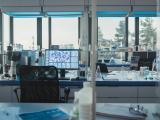Aug 15, 2011 (CIDRAP News) – A large, multi-center study of how well the 2009 H1N1 vaccines performed in the United States during the pandemic found that it offered significant protection, especially in older children and nonelderly adults, and had the ability to cut the number of flu-related doctor visits by at least half.
The study is one of the few large investigations that have measured the effectiveness of unadjuvanted pandemic vaccines. When the pandemic virus emerged in April 2009, US health officials had to make a choice between ordering unadjuvanted monovalent vaccine, based on routine seasonal flu vaccine production practices, or an adjuvanted vaccine that could have stretched the number of doses but might have faced a slower approval process and a more difficult reception from the public.
To gauge the effectiveness of four pandemic flu vaccines that became available during the nation's fall flu wave, researchers assessed people who were treated for respiratory illnesses at selected clinical systems in Marshfield, Wis., Ann Arbor and Detroit, Mich., Rochester, N.Y., and Nashville, Tenn. All are part of the US Centers for Disease Control and Prevention (CDC) Influenza Vaccine Effectiveness (Flu-VE) Network.
The group published its findings in the Aug 12 online edition of Public Library of Science (PLoS) ONE. Licensed pandemic vaccines in the US included four unadjuvanted vaccines, three of them inactivated and one live attenuated. They launched by Oct 1, 2009.
To study their effectiveness in the field, the researchers enrolled patients seeking treatment for respiratory infection between Sep 1, 2009, and May 31, 2010. Patients were identified at the clinics and hospitals during screening procedures. They or their parents or guardians were interviewed to assess symptoms and onset, age, gender, insurance status, and history of chronic medical conditions. In three communities patients or their representatives reported vaccination status, but in the Marshfield area, researchers used a registry to confirm vaccine receipt. Patients were classified as vaccinated if they had received the vaccine more than 14 days before symptom onset.
Respiratory specimens were obtained from each of the 6,757 enrolled patients included in the analysis and tested using real-time reverse transcriptase polymerase chain reaction (rRT-PCR). Those who tested positive for the 2009 H1N1 virus were considered cases, and the ones who tested negative were the controls. Researchers estimated vaccine effectiveness using logistic regression models that adjusted for several factors including study community, patient age, timing of illness, and insurance status.
Pandemic activity at the four geographic sites peaked just as the vaccine became available, the authors noted.
Overall, pandemic virus was detected in 15% (1,011) of the patients. Of that group, 1% (15) had been vaccinated more than 14 days before illness onset. Of the patients who tested negative for the virus, 18% had received the pandemic vaccine more than 14 days before they got sick.
Researchers calculated the overall effectiveness of the pandemic vaccine at 56%. For the inactivated vaccine, they found that vaccine effectiveness was 89% (95% confidence interval [CI], 15% to 99%) in those aged 10 to 49, though they didn't find significant effectiveness in younger and older groups. Effectiveness in children aged 6 months to 9 years was 32% (95% CI, -92% to 76%), and for people over 50 it was -6% (95% CI, -231% to 66%).
The authors noted that the good vaccine effectiveness in healthy young adults isn't surprising for a pandemic vaccine that closely matches the circulating strain. However, they wrote that the wide confidence interval should be interpreted with caution, keeping in mind that recent clinical trials of seasonal flu vaccines have shown that inactivated vaccines perform better than live-attenuated vaccines in this age-group.
The lack of effectiveness they found of one dose of inactivated vaccine in young children was expected, given that two doses are recommended for full protection. Few children younger than 10 had received two doses of the vaccine. A secondary analysis of the live attenuated vaccine in young children, including those who were vaccinated just 7 or more days before they got sick, found that one dose was 82% effective in those aged 2 to 9 years (95% CI, 14% to 96%).
The findings are consistent with those of another large study of the unadjuvanted pandemic vaccine, which involved Chinese school children, the group noted.
Observation of how the vaccines perform in the field complement data from clinical trials to fill in a more complete picture of flu vaccine effectiveness, the authors wrote, commenting, "Clinical trials for licensure of inactivated vaccines rely in part on immunogenicity data, which are not ideal predictors of efficacy."
The group said large annual studies are needed to make vaccine- and age-specific estimates of vaccine effectiveness, given the nation's recommendation for universal flu vaccination.
Griffin MR, Monto AS, Belongia EA, et al. Effectiveness of non-adjuvanted pandemic influenza A vaccine for preventing pandemic influenza acute respiratory illness visits in 4 US communities. PLoS ONE 2011 Aug; 6(8): [Full text]



















